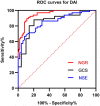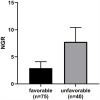The ratio of serum neuron-specific enolase level to admission glasgow coma scale score is associated with diffuse axonal injury in patients with moderate to severe traumatic brain injury
- PMID: 36119705
- PMCID: PMC9475250
- DOI: 10.3389/fneur.2022.887818
The ratio of serum neuron-specific enolase level to admission glasgow coma scale score is associated with diffuse axonal injury in patients with moderate to severe traumatic brain injury
Abstract
Background: Moderate to severe traumatic brain injury (TBI) is frequently accompanied by diffuse axonal injury (DAI). Considering the low sensitivity of computed tomography (CT) examination for microbleeds and axonal damage, identification of DAI is difficult using conventional diagnostic methods in the acute phase. Neuron-specific enolase (NSE) has been demonstrated to be increased in serum following various types of TBI and is already clinically/commercially available. We conjecture that serum NSE level to admission GCS score ratio (NGR) may be a useful indicator for the early diagnosis of DAI.
Methods: This study included 115 patients with moderate-to-severe TBI who underwent NSE measurements within 6 h after injury and brain magnetic resonance imaging (MRI) within 30 days. The positive and negative DAI groups were divided according to MRI findings.
Results: Among the 115 patients, 49 (42.6%) were classified into the DAI group and 66 (57.4%) patients into the non-DAI group by clinical MRI. The NGR of patients without DAI was found to be significantly lower than those of patients with DAI (p < 0.0001). NGR presented the largest Pearson r value (r = 0.755, 95% CI 0.664-0.824, p < 0.0001) and high diagnostic accuracy for DAI [area under the curve (AUC) = 0.9493; sensitivity, 90.91%; and specificity, 85.71%]. Patients with TBI presenting with higher NGR were more likely to suffer an unfavorable neurological outcome [6-month extended Glasgow Outcome Scale (GOSE) 1-4].
Conclusions: The NGR on admission could serve as an independent predictor of DAI with moderate-to-severe TBI.
Keywords: biomarker; diffuse axonal injury; early diagnosis; neuron specific enolase; traumatic brain injury.
Copyright © 2022 Chen, Wang, Yao, Zhu, Chen, Su and Jiang.
Conflict of interest statement
The authors declare that the research was conducted in the absence of any commercial or financial relationships that could be construed as a potential conflict of interest.
Figures




References
-
- Skandsen T, Kvistad KA, Solheim O, Strand IH, Folvik M, Vik A. Prevalence and impact of diffuse axonal injury in patients with moderate and severe head injury: a cohort study of early magnetic resonance imaging findings and 1-year outcome. J Neurosurg. (2010) 113:556–63. 10.3171/2009.9.JNS09626 - DOI - PubMed
LinkOut - more resources
Full Text Sources

